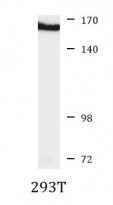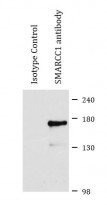ARG57846
anti-SMARCC1 antibody
anti-SMARCC1 antibody for Immunoprecipitation,Western blot and Human
Overview
| Product Description | Rabbit Polyclonal antibody recognizes SMARCC1 |
|---|---|
| Tested Reactivity | Hu |
| Tested Application | IP, WB |
| Host | Rabbit |
| Clonality | Polyclonal |
| Isotype | IgG |
| Target Name | SMARCC1 |
| Antigen Species | Human |
| Immunogen | Recombinant protein of Human SMARCC1. |
| Conjugation | Un-conjugated |
| Alternate Names | Rsc8; SRG3; SWI3; BAF155; CRACC1; SWI/SNF complex subunit SMARCC1; BAF155; BRG1-associated factor 155; SWI/SNF-related matrix-associated actin-dependent regulator of chromatin subfamily C member 1; SWI/SNF complex 155 kDa subunit |
Application Instructions
| Application Suggestion |
|
||||||
|---|---|---|---|---|---|---|---|
| Application Note | * The dilutions indicate recommended starting dilutions and the optimal dilutions or concentrations should be determined by the scientist. | ||||||
| Positive Control | 293T |
Properties
| Form | Liquid |
|---|---|
| Purification | Affinity purified. |
| Buffer | PBS (pH 7.3), 0.02% Sodium azide and 50% Glycerol. |
| Preservative | 0.02% Sodium azide |
| Stabilizer | 50% Glycerol |
| Storage Instruction | For continuous use, store undiluted antibody at 2-8°C for up to a week. For long-term storage, aliquot and store at -20°C. Storage in frost free freezers is not recommended. Avoid repeated freeze/thaw cycles. Suggest spin the vial prior to opening. The antibody solution should be gently mixed before use. |
| Note | For laboratory research only, not for drug, diagnostic or other use. |
Bioinformation
| Database Links | |
|---|---|
| Gene Symbol | SMARCC1 |
| Gene Full Name | SWI/SNF related, matrix associated, actin dependent regulator of chromatin subfamily c member 1 |
| Background | The protein encoded by this gene is a member of the SWI/SNF family of proteins, whose members display helicase and ATPase activities and which are thought to regulate transcription of certain genes by altering the chromatin structure around those genes. The encoded protein is part of the large ATP-dependent chromatin remodeling complex SNF/SWI and contains a predicted leucine zipper motif typical of many transcription factors. [provided by RefSeq, Jul 2008] |
| Function | Involved in transcriptional activation and repression of select genes by chromatin remodeling (alteration of DNA-nucleosome topology). May stimulate the ATPase activity of the catalytic subunit of the complex. Belongs to the neural progenitors-specific chromatin remodeling complex (npBAF complex) and the neuron-specific chromatin remodeling complex (nBAF complex). During neural development a switch from a stem/progenitor to a postmitotic chromatin remodeling mechanism occurs as neurons exit the cell cycle and become committed to their adult state. The transition from proliferating neural stem/progenitor cells to postmitotic neurons requires a switch in subunit composition of the npBAF and nBAF complexes. As neural progenitors exit mitosis and differentiate into neurons, npBAF complexes which contain ACTL6A/BAF53A and PHF10/BAF45A, are exchanged for homologous alternative ACTL6B/BAF53B and DPF1/BAF45B or DPF3/BAF45C subunits in neuron-specific complexes (nBAF). The npBAF complex is essential for the self-renewal/proliferative capacity of the multipotent neural stem cells. The nBAF complex along with CREST plays a role regulating the activity of genes essential for dendrite growth (By similarity). [UniProt] |
| Cellular Localization | Nucleus. [UniProt] |
| Calculated MW | 123 kDa |
| PTM | Phosphorylated on undefined residues at the G2/M transition by ERK1 and other kinases. This may contribute to cell cycle specific inactivation of remodeling complexes containing the phosphorylated protein. [UniProt] |
Images (2) Click the Picture to Zoom In
-
ARG57846 anti-SMARCC1 antibody WB image
Western blot: 25 µg of 293T cell lysate stained with ARG57846 anti-SMARCC1 antibody at 1:1000 dilution.
-
ARG57846 anti-SMARCC1 antibody IP image
Immunoprecipitation: 200 µg extracts of 293T cells were immunoprecipitated and stained with ARG57846 anti-SMARCC1 antibody at 1:1000 dilition.







